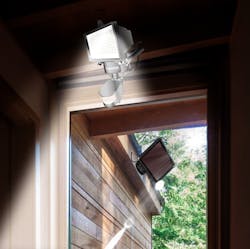Solar Lighting
A Green And Sustainable Lighting Option In India
Proper lighting with a good colour combination can do wonders for improving the ambience of a place. But improper usage can lead to energy wastage. Solar Lighting has emerged as a viable option – it is environment friendly and cheaper...
- Vineeth Manathil
There are certain critical areas that needs to be analyzed before using solar power:
- How much Energy does your establishment need?
- What will be the size of the solar system to meet your energy demand?
- Will you be completely off the grid or partially connected?
- Should you use CFL or LED options for solar lighting?
- Should you use timers to turn outdoor decorative lighting on and off?
How does it work?
Solar Energy is abundantly available in India and it has been estimated that solar panels installed on less than 1% of the country’s landmass should be enough to meet the entire energy needs. Solar lights charge up during the day absorbing energy with the help solar cells. This energy is then stored in rechargeable batteries. At night time, this stored energy is converted back into light. This is a green, sustainable way of lighting since it not only reduces the electricity bills but is clean and non-polluting as well. It avoids using electricity generated from fossil fuel based power plants.
Scope
Solar lighting is all set to become the next generation lighting option in India. Approximately 60% of population in India does not have access to electricity. This percentage is even higher in case of rural India which mostly uses subsidized kerosene or biomass to light their homes. About 100,000 Indian villages do not access to the electricity grid which means that work comes to a halt in the dark. Kerosene which is highly polluting is the main source of energy for millions of Indian citizens. It is also a health hazard as smoke from kerosene lamps leads various to respiratory diseases and sometimes causes accidental fires as well.
Solar lights is a safe and green alternative to fossil fuel powered lighting. The Ministry of New and Renewable Energy of India has issued policies to deploy 20 million solar lighting systems for rural areas by 2022. Though the market is still nascent, it is growing rapidly. Energy is a basic necessity like food and water and it is a fundamental right even for the poorest of the poor. The government has targeted to provide 24/7 power to every citizen in India and solar lighting can go a long way in meeting those goals.
Solar lighting makes a lot of sense in areas where there is no grid connectivity. Using solar powered lights can avoid connecting these places with the power grid; thus, saving on transmission costs. In India, even the main cities suffer from long, unscheduled power cuts. Given the large demand from both rural and urban areas, there is an expectation that the demand for solar lighting will increase rapidly in the future. A forecast from Navigant Research predicts shipments of LED-based street lights will be more than 17 million by 2020. It has also been estimated that there will be a production of 3.5 million solar lanterns by the end of 2015.
Advantages of solar lighting
- Low Cost – Since solar lights use light from the sun, it is independent of the power grid. There is no electricity costs and no fuel cost as sunlight is free. A basic solar lamp can be bought at a pocket friendly price of ~ INR 500-600.
- Clean and Green – Solar lights are an environment friendly way of lighting up. They use clean energy from the sun for their working, hence there is no pollution. Solar lights are do not emit greenhouse gas emissions and require no dirty fuel.
- Safe – Unlike the conventional lights, there are no wires associated with the solar lights and so there is less risk of accidents. Usage of kerosene in lamps have caused numerous accidents and are also responsible for respiratory problems and poor eyesight.
- Low Maintenance – The maintenance associated with solar lights is much less as compared to the normal lights. Regular cleaning of the panels with a dry cloth and warm soapy water is enough to run the lights for a very long time.
Types of solar lights in India
A wide variety of solar lighting products exist in the market such as solar torches, solar lamps/ solar lanterns, solar multifunctional devices including solar charging of simple devices and solar home systems.
Solar lamps or solar lanterns have become popular in India because of the lack of access to electricity and the high costs of kerosene lamps. They are not only economical but also help reduce the number of accidents and health issues due to kerosene lamps. LEDs can be used in these lamps to further improve the efficiency of the lamps.
A typical solar home lighting system consist of solar panels, mounting structure, battery, battery box, solar charge-controller, luminaries, cables and switches. The Solar lighting fixtures have inbuilt DC to AC inverter converters. They can be used to run household appliances on a daily basis.
Solar Street Lighting System is a lighting system for illuminating streets and cross roads located in areas that are not connected to the power grid. Standalone solar street lighting system comprises of a solar panel, lead acid battery for energy storage, compact fluorescent lamp (CFL)/ LED lamps as light source, suitable electronics and hard-ware like pole, battery box for fixing of these sub system. The system is controlled by a controller with automatic on/off time switch, which controls the light from dusk till morning.
The falling prices of LEDs has made it possible to couple these two green technologies together. Solar LED Lighting can be used anywhere as a replacement for normal solar lighting which uses CFLs. Solar LED lights are mainly used as decorative and garden lights.
Solar garden lights are decorative lights that are used for garden lighting. They come in a variety of designs and are commonly seen around swimming pools or for marking footpaths.
Suppliers in India:
Online Store : https://hardollenterprises.com/solar-lights
The number of solar lights manufacturers in India is growing steadily. Hardoll Enterprises LLP is a social enterprise that was established in 2016, to provide services to the under-privileged of the society. It has sold more than 10 thousand solar systems till date and provides easy financing options as well. D.Light Design also started with a charter for social responsibility by bringing affordable lighting to millions of poor. Its flagship product is S250 which is a dual purpose solar light and mobile charger. Tata Solar which is one of India’s largest solar companies also manufactures a wide range of solar lighting solutions based on both LED and non LED lights. Philips the leader of lighting solutions in India, also manufactures aesthetic and sophisticated solar lighting products. It mainly manufacturers solar street lights and decorative lighting pieces running solar power. Globally, Africa is set to become the world’s largest market for solar lamps. There has been an increasing demand for cost effective sustainable lighting in Asian and African countries. This has led to the maturing of solar off-grid lighting industry. China is the largest manufacturer of solar lights globally. These countries possess immense potential for growth in future. The government in these countries are also promoting off-grid lighting.
Conclusion
More than 500K solar home systems were sold in 2014 and the market is expected to grow at 60% annually in India. It was estimated that approximately 900K homes were using solar home systems, offsetting 39,000 tons of carbon emissions in 2014. Improving affordability, better access and government support are the main drivers behind increasing demand for solar lights. Solar Lighting will not only be restricted to rural applications but will also be increasingly used as commercial lighting in India. The Indian government has mostly subsidized large scale solar farms for grid connected power which mostly benefits large developers and investors. This has resulted in the rooftop solar and off grid solar segment being a tiny fraction of the large solar farm segment. The government needs to shift its priority and provide more impetus to solar lighting to meet India’s climate change goals.






